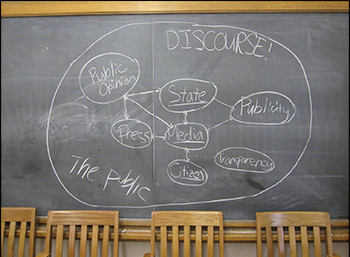Media Theory

Course introduction
_____________________________________________________________________________________
|
|
Media Theory
MARÍA LUENGO
|
The course is divided into 12 lectures and 12 seminars, each of them of 90 minutes.
PRERREQUISITES AND RECOMMENDED PREVIOUS KNOWLEDGE
The Media Theory course is offered to students who are in their first academic year. It is intended to provide students general, basic knowledge of major theories of the media. Because of this, no special knowledge or skills are required to apply for the course. Nonetheless, students must have a high level of English as they have to be capable of reading, writing about and discussing in English a range of scholarly texts from the social sciences.GENERAL DESCRIPTION OF THE COURSE
The course examines theoretical frameworks for thinking across media forms and their relation to society. It explores different theoretical domains from three different angles: historical, critical-analytical and experiential. Each week students will reflect on the work of leading contributors to the theory of media and, in particular, journalism. The class combines lectures and seminars. Coursework and group activities are designed to encourage students not to replicate theories but use them to think by themselves, illustrating concepts with real-life examples and trying to understand the changing conceptions of contemporary media.
OBJECTIVES: KNOWLEDGE AND SKILLS
At the end of the course, students will be able to:
1. Have an overall sense of the leading theories in the field of media and journalism studies.
2. Better understand the development of the main theoretical paradigms that have been applied to explain the role of media in society.
3. Challenge accepted views of the media from a thoughtful understanding of them.
TEACHING MATERIAL
The course includes selected lectures notes and assignments.
PRACTICAL ASSIGMENTS AND ASSESSMENT ACTIVITIES
- Five-Page Essay
This five-page paper provides an opportunity to approach one of the weekly readings from the course in an analytical work. This paper will be presented at the seminar related to the topic of the text.
- Short Weekly Comments
These short (350-word) critical comments on the weekly readings will be brought to class every week. They will serve to extend the conversation opened up by the group which will be presenting the paper on a particular text. They will also allow you to share interests, questions and concerns related to the theory covered by the text.
- Midterm and final exam
